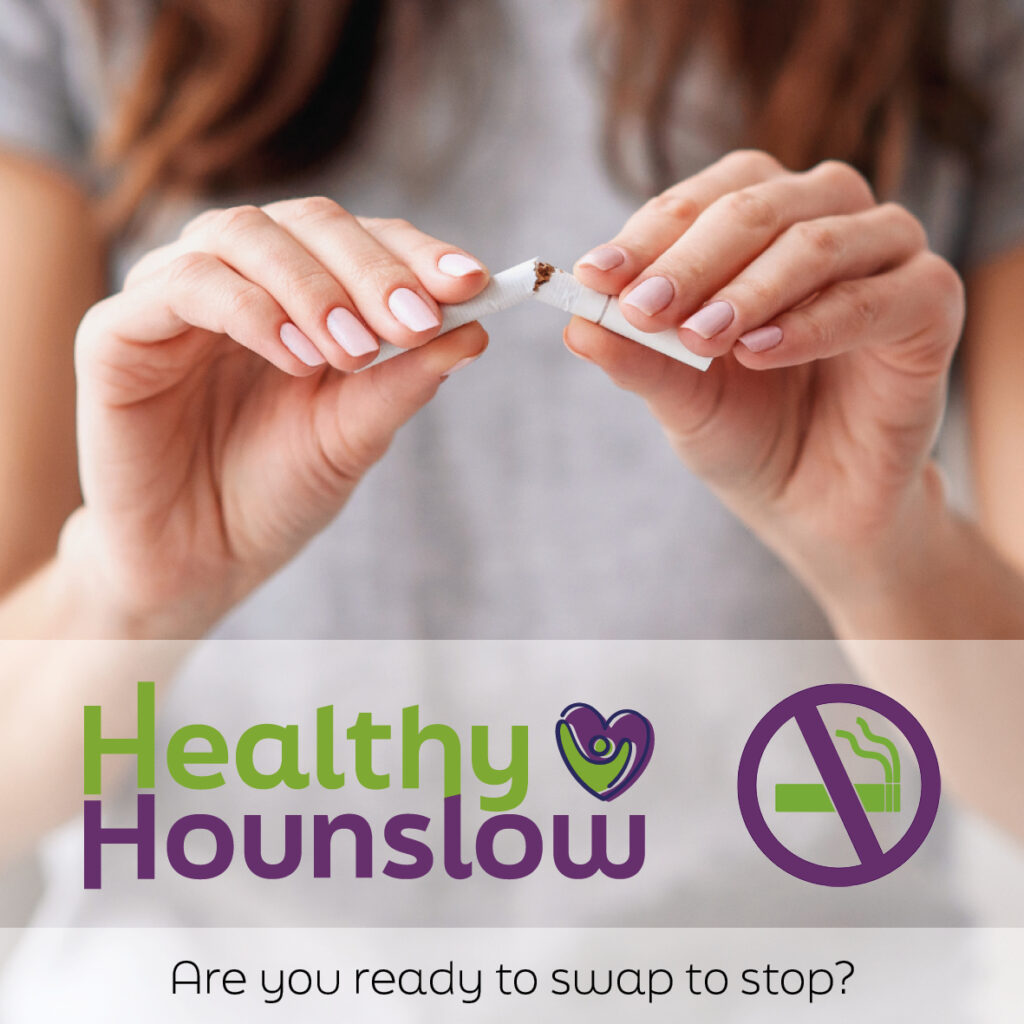Stop Smoking this New Year with Healthy Hounslow
Make 2024 your best year yet!
Did you know that coming along to your local stop smoking service for free support and treatment increases your chances of being smoke-free?
One of the most valuable tools to prevent against relapse is to be thorough with your preparation and planning to quit both initially and on-going throughout your tobacco free journey. This includes:
- Learning from previous lapses and quit attempts
- Recognise and anticipate situations where you might be at an increased risk of relapse
- Prepare yourself with distractions and coping strategies
- Reflect on the positive gains to come from quitting
- Focus on your reasons and motivations for wanting to stop smoking
- Say out loud ‘Not one puff ever’. For each urge you resist, you are one step closer to becoming a non-smoker for good

Plan your quit
Preparation and planning play a really important role in successfully quitting smoking. A plan helps you stay focused and motivated and increases your chances of getting through cravings. By exploring your smoking habits and having strategies ready to put in place, your chances of success increase.
Smoking routines are connected with many daily activities, creating what we call ‘triggers’, making it hard to do those activities without smoking. An example might be having a cigarette with a cup of coffee when you talk on the phone, or after meals. So, the ‘trigger’ would be drinking coffee, picking up your phone to make a call or finishing eating. This then sends a signal to your brain that you should be smoking now. Emotions such as stress, sadness or anger might also stand out as being a smoking trigger for you.
Making a list of your main smoking triggers/habits is a great place to start. Make a list of coping strategies that would be appropriate for each of these times. An example could be that after a meal, you clear away your plate, wash up and then go to brush your teeth. Having these distractions and plans in place before you quit will be useful and give you a better chance of beating cravings.
Tips and setting a quit date
When choosing to quit smoking, select a suitable day by considering your activities, locations, and social engagements. Plan the first few days strategically for a successful start. On the day before quitting, eliminate all smoking-related items, such as cigarettes, tobacco, lighters, and ashtrays, to minimize initial temptations.
Try to plan ahead and think about the next week, what you will be doing, where you will be going, and who will be seeing. Are any of these plans or situations going to be challenging? Is there anything you can plan differently or just make sure you have plans in place for cravings?
Think about who you’re going to tell about quitting. Having the support of friends, family, work colleagues or even strangers going through the same experience can be helpful. It might be that you want to join an online forum or a friendly Facebook group. This additional support from other people quitting is really valuable.
Quit together – Is there a friend who wants to quit smoking too? Maybe you could do this together.
Before quitting smoking, stock up on snacks and consider switching to flavored coffee to disrupt associations. If using stop smoking treatments or a vape, prepare them the day before quitting and familiarize yourself with their usage. Avoid frequenting stores where you bought cigarettes and consider changing your route to minimize triggering situations.
Reward yourself after a smoke-free week with a small treat like fresh flowers, new music, or an engaging audiobook. Consider saving the money you would have spent on smoking for a bigger reward, such as a weekend getaway or holiday.
Stop smoking treatments
Not only will a stop-smoking treatment support you in being successful in quitting tobacco, but it will also reduce cravings and withdrawal symptoms. Treatment options include nicotine replacement therapy (NRT), Champix* and Zyban
*(Champix is currently unavailable in the UK)
NRT only contains nicotine, so none of the chemicals (tar) or carbon monoxide like cigarettes and other forms of tobacco do. It’s important to remember that nicotine isn’t the harmful part of the tobacco, making NRT both safe and effective.
NRT works by providing a small, controlled amount of nicotine to the receptors in the brain where it’s being craved. The amount of nicotine is reduced gradually over approximately 12 weeks when you stop the treatment. The cells in the brain that crave nicotine take approximately 12 weeks to ‘shut down’ from craving so you wouldn’t suddenly get physical cravings when coming off a nicotine treatment unless you smoke a cigarette.
Patches
Use 1 new patch each day. Put a new patch on each morning (for both 16-hour and 24-hour patches).
Gum
Use regularly throughout the day with a maximum of 15 pieces per day. Use the chew and park technique to maximise absorption of nicotine through the lining of your mouth.
Lozenges
Use regularly throughout the day with a maximum of 15 pieces per day. Suck and park technique to maximise the absorption of nicotine through the lining of the mouth. Various lozenges; original, minis and cools.
Nasal Spray
Use a maximum of 2 sprays up each nostril every hour or 64 in total over a 24-hour period. Persevere over the 1st day of using this, it can take a little adjusting to.
Mouth Spray
Use 1-2 sprays every 30 minutes to 1 hour. A maximum of 64 sprays in a 24-hour period, and no more than 2 sprays per dosing episode. Spray towards the inside lining of your cheek rather than the back of your throat to maximise absorption.
Inhalator
Use up to 6 cartridges per day. 1 cartridge has approximately 20 minutes of constant puffing. Usually, people find they just use it for a few minutes then go back to it 20 minutes or so later. You might not be able to notice when a cartridge needs changing so even if you have barely used it during the morning, make sure you change the cartridge for the afternoon and evening.
Champix (currently unavailable in the UK)
This is a medication available on prescription via a GP. It is a 12-week course of tablets. You continue smoking when you start the treatment, setting a quit date somewhere between days 7 and 14 of the tablets.
From day 1 to day 3, you should take one white CHAMPIX 0.5 mg film-coated tablet once a day. Recommended to take this in the morning after breakfast with water.
From day 4 to day 7, you should take one white CHAMPIX 0.5 mg film-coated tablet twice daily, once in the morning and once in the evening, at about the same time each day. Again, it is recommended to take this after food with plenty of water.
From day 8 to day 14, you should take one light blue CHAMPIX 1 mg film-coated tablet twice daily, once in the morning and once in the evening, at about the same time each day.
From day 15 until the end of treatment, you should take one light blue CHAMPIX 1 mg film-coated tablet twice daily, once in the morning and once in the evening, at about the same time each day.
As this is a prescription-only medication, your GP will check your medical history to make sure you are suitable for using this treatment due to some cautions and reasons why some people wouldn’t be suited to taking it.
Zyban
This is an eight-week course of treatment, and you are still smoking when you start taking the treatment.
- Start by taking one tablet in the morning each day for six days. Then increase to one tablet twice a day, at least eight hours apart
- Usually recommended to take one tablet after waking with breakfast and the second 8 hours later (but not too close to bedtime if possible)
- Set a target date to stop smoking within the first 2 weeks after starting the treatment. This allows Zyban to build up in your body and you feel the effects before you stop completely
- You should continue the tablets for a further seven weeks
This is a prescription-only medication so your GP will check your medical history to make sure you are suitable for using this treatment as there are a number of cautions and interactions Zyban can have with other medications and medical conditions, both past and present.
For more information about stop smoking treatments: Stop smoking treatments – NHS
Vaping
Vaping is very popular when quitting smoking and is now a recommended tool to support stopping smoking (over 18’s only). Recent evidence has confirmed that vaping is significantly less harmful than smoking, with NICE guidance encouraging vaping as a first-line treatment to assist in quitting.
Vaping can offer both the nicotine you crave along with helping satisfy the habit of the hand-to-mouth action.
E-liquids are available in a variety of nicotine strengths from 20mg (also called 2%), which is the highest level of nicotine in UK-regulated e-liquids, right down to nicotine-free (also called 0%). In the UK there are regulations for vaping devices and e-liquids, ensuring they comply with certain standards, for example, nicotine content is limited to 20 milligrams per millilitre mg/ml. Vaping should only be used as a tool to quit smoking and to prevent relapse back to smoking.
Some people aim to reduce the strength of nicotine in the e-liquid over approximately 12 weeks, just as we would with Nicotine Replacement Treatments, while other people continue vaping longer term if they are concerned about going back to smoking. The choice is yours!
It is important to always buy products from a reputable retailer to ensure safety and quality. This includes the device, the chargers and e-liquids.
Sign up for support from Healthy Hounslow’s stop smoking service today to find out more about getting hold of a free vape and e-liquids for up to 12 weeks.
Top tips to stay smoke free
- Keep your mouth busy – chew gum, suck on a mint or lollipop, chew on a toothpick, or a handful of nuts
- Physical activity not only reduces cravings but is a great distraction from smoking and helps you manage stress
- Take a deep breath through your nose and blow out slowly through your mouth, repeat this 10 times
- Freshen your mouth by brushing your teeth or rinsing with mouthwash
- Message or call a friend – ask what they’ve been up to. This can help distract your mind from cravings
- Keep your mind busy by reading, doing a puzzle, baking, listening to an audiobook, putting your favourite music
- Do some odd jobs such as cleaning, tidying or even filing some paperwork
- Not only does this keep your hands busy, but you can enjoy the smell of this rather than that of tobacco
- Write down your reasons for quitting
- Get outside, take yourself away from a trigger situation
- Have plans ready for when other people light up around you
- Plan a reward for yourself
- Keep in mind all the reasons why you want to be smoke-free!



